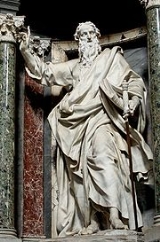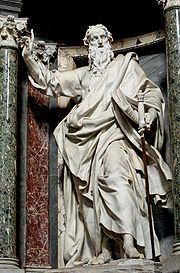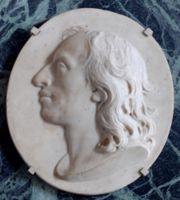
Pierre-Étienne Monnot
Encyclopedia

Baroque
The Baroque is a period and the style that used exaggerated motion and clear, easily interpreted detail to produce drama, tension, exuberance, and grandeur in sculpture, painting, literature, dance, and music...
idiom.
Monnot was born at Orchamps-Vennes, Doubs
Doubs
Doubs is a department the Franche-Comté region of eastern France named after the Doubs River.-History:As early as the 13th century, inhabitants of the northern two-thirds of Doubs spoke the Franc-Comtois language, a dialect of Langue d'Oïl. Residents of the southern third of Doubs spoke a dialect...
, Franche-Comté
Franche-Comté
Franche-Comté the former "Free County" of Burgundy, as distinct from the neighbouring Duchy, is an administrative region and a traditional province of eastern France...
, and brought up at Besançon
Besançon
Besançon , is the capital and principal city of the Franche-Comté region in eastern France. It had a population of about 237,000 inhabitants in the metropolitan area in 2008...
. Trained at first by his father, he was apprenticed to a sculptor at Dijon
Dijon
Dijon is a city in eastern France, the capital of the Côte-d'Or département and of the Burgundy region.Dijon is the historical capital of the region of Burgundy. Population : 151,576 within the city limits; 250,516 for the greater Dijon area....
, then developed his style during a decade in Paris
Paris
Paris is the capital and largest city in France, situated on the river Seine, in northern France, at the heart of the Île-de-France region...
in the studio of Pierre Le Gros the Elder
Pierre Le Gros the Elder
Pierre Le Gros the Elder was a French sculptor whose output was largely absorbed by the decoration of the château and the gardens of Versailles, often working to designs provided by Charles Le Brun and collaborating with other sculptors of the Bâtiments du Roi...
(ca. 1677-87), before returning to his home region, where commissions for religious works on a small scale took him to Besançon and Poligny.
By about 1690 he was in Rome, where there was an established, tightly-knit community of Burgundian artists. Monnot was influenced by Domenico Guidi
Domenico Guidi
Domenico Guidi was a prominent Italian Baroque sculptor.Born in Carrara, Guidi followed his uncle, the prominent sculptor, Giuliano Finelli to Naples. As the nephew of a sculptor noted for his feud with Bernini, it is not surprising that Guidi was never employed by the eminent master...
, to the extent that scholars have debated the attribution between Guidi and Monnot of the Burghley House Andromeda. Guidi, a pupil of Alessandro Algardi
Alessandro Algardi
Alessandro Algardi was an Italian high-Baroque sculptor active almost exclusively in Rome, where for the latter decades of his life, he was the major rival of Gian Lorenzo Bernini.-Early years:...
, had become a prominent Roman sculptor with Bernini's death in 1680. Monnot's first major commission was for two marble reliefs, a Nativity and a Flight into Egypt flanking Guidi's Dream of St. Joseph for the right transept altar in Santa Maria della Vittoria
Santa Maria della Vittoria
Santa Maria della Vittoria is a roman catholic titular church and minor basilica dedicated to the Virgin Mary located in Rome, Italy. The church is known for the masterpiece of Gian Lorenzo Bernini in the Cornaro Chapel, the Ecstasy of Saint Teresa....
.
Monnot quickly intregrated into Rome's artistic circles and gained many commissions. With the award of the Saint Ignatius altar in the Church of the Gesù
Church of the Gesu
The Church of the Gesù is the mother church of the Society of Jesus, a Roman Catholic religious order also known as the Jesuits. Officially named , its facade is "the first truly baroque façade", introducing the baroque style into architecture ,. The church served as model for innumerable Jesuit...
, to Le Gros the Younger
Pierre Le Gros the Younger
Pierre Le Gros was a French sculptor, active almost exclusively in Baroque Rome. Nowadays, his name is commonly written Legros, while he himself always signed as Le Gros; he is frequently referred to either as 'the Younger' or 'Pierre II' to distinguish him from his father, Pierre Le Gros the...
in 1695, French sculptors in Rome became highly prized for decades to come. He was among the select group who were commissioned to provide apostles of heroic scale for niches in the Basilica of Saint John Lateran.
Commissions arrived from the English visitor, the Earl of Exeter, and above all from Kassel
Kassel
Kassel is a town located on the Fulda River in northern Hesse, Germany. It is the administrative seat of the Kassel Regierungsbezirk and the Kreis of the same name and has approximately 195,000 inhabitants.- History :...
, where Monnot was responsible for the tour de force of white marble sculptures and bas-reliefs set against richly-colored marble revetments of the Marmorbad (the "Marble Bath") in Orangerie
Orangerie (Kassel)
The Orangerie is a Orangery in Kassel. It was built under Landgrave Charles between 1703 and 1711. Since then, it forms the northern corner of the Karlsaue park. Today it is used as an astronomy and physical cabinet.- History :...
ath the Karlsaue, Kassel
Kassel
Kassel is a town located on the Fulda River in northern Hesse, Germany. It is the administrative seat of the Kassel Regierungsbezirk and the Kreis of the same name and has approximately 195,000 inhabitants.- History :...
, which is considered his masterwork. Monnot went to Kassel in 1714, and began by executing marble portrait busts of Karl, Landgrave of Hesse-Kassel
Hesse-Kassel
The Landgraviate of Hesse-Kassel or Hesse-Cassel was a state in the Holy Roman Empire under Imperial immediacy that came into existence when the Landgraviate of Hesse was divided in 1567 upon the death of Philip I, Landgrave of Hesse. His eldest son William IV inherited the northern half and the...
(or Hesse-Cassel), and the Landgrafin. In January 1715 the first contracts were signed concerning the new Appartement du Bain with its statuary, ten sculptures that were already completed in Rome, some of them as early as 1692, and commissioned four white marble high relief panels for the outerwalls of the pavilion, eight further relief panels for the vaulting and the portrait medalion of Karl himself. Monnot established a studio with assistants in Kassel and to help him produce the works. Renewed agreements in 1718 increased the marble relief panels to the eight that were installed, and the ensemble was inaugurated in 1729. The final two statues, Minerva and Aurora, were announced as ready by Monnot in 1731, but did not actually reach Kassel until 1734.
The architect of the garden pavilion
Pavilion (structure)
In architecture a pavilion has two main meanings.-Free-standing structure:Pavilion may refer to a free-standing structure sited a short distance from a main residence, whose architecture makes it an object of pleasure. Large or small, there is usually a connection with relaxation and pleasure in...
is unknown; Monnot's mythological sculptures occupy niches in the massive central pier, and his eight large white marble high relief panels of subjects from Ovid's Metamorphoses
Metamorphoses (poem)
Metamorphoses is a Latin narrative poem in fifteen books by the Roman poet Ovid describing the history of the world from its creation to the deification of Julius Caesar within a loose mythico-historical framework. Completed in AD 8, it is recognized as a masterpiece of Golden Age Latin literature...
fill the piers between arch-headed windows.
Like all sculptors working in Rome, Monnot was called upon to restore fragmentary antiquities. Baroque restorations often took broader liberties of interpretation than eighteenth-century and later tastes permitted. Monnot restored a torso of a copy after Myron's Discobolus
Discobolus
The Discobolus of Myron is a famous Greek sculpture that was completed towards the end of the Severe period, circa 460-450 BC. The original Greek bronze is lost...
as a Wounded Gladiator who supports himself on his arm as he sinks to the ground; it was donated before 1734 by Pope Clement XII
Pope Clement XII
Pope Clement XII , born Lorenzo Corsini, was Pope from 12 July 1730 to 6 February 1740.Born in Florence, the son of Bartolomeo Corsini, Marquis of Casigliano and his wife Isabella Strozzi, sister of the Duke of Bagnuolo, Corsini had been an aristocratic lawyer and financial manager under preceding...
to the Capitoline Museums, where it remains. He died in Rome
Rome
Rome is the capital of Italy and the country's largest and most populated city and comune, with over 2.7 million residents in . The city is located in the central-western portion of the Italian Peninsula, on the Tiber River within the Lazio region of Italy.Rome's history spans two and a half...
. One of his pupils, Bartolomeo Cavaceppi
Bartolomeo Cavaceppi
Bartolomeo Cavaceppi was an Italian sculptor who worked in Rome, where he trained in the studio of the acclimatized Frenchman, Pierre-Étienne Monnot, and then in the workshop of Carlo Antonio Napolioni, a restorer of sculptures for Cardinal Alessandro Albani, who was to become a major patron of...
(1716–1799), was a sculptor best known as a restorer of antiquities.
Works

- Tabernacle for the church at VesoulVesoulVesoul is a commune in the Haute-Saône department in the region of Franche-Comté in eastern France.The town is the capital of the department, its inhabitants are known in French as Vésuliens.-Notable people:...
. - Retable for the chapel of Saint Laurent, Besançon.
- Works for the Priory of Vaux-sous-Poligny, Jura.
- Busts of Christ and of the Virgin, terracotta (Musée des Beaux-Arts, Besançon)
- Five reliefs of the Passion in lindenwood for the chapel of the Oratorians, Poligny (Hôtel de Ville, Poligny). One of them carried the date 1688, his earliest dated work.
- Nativity and The Flight into Egypt, marble high reliefs for the Capocaccia Chapel, the right transept altar of Santa Maria della VittoriaSanta Maria della VittoriaSanta Maria della Vittoria is a roman catholic titular church and minor basilica dedicated to the Virgin Mary located in Rome, Italy. The church is known for the masterpiece of Gian Lorenzo Bernini in the Cornaro Chapel, the Ecstasy of Saint Teresa....
, 1695-99. The main relief of the altar is Domenico Guidi's Dream of Saint Joseph. - Angels for the monument of Pope Gregory XV, Sant'Ignazio, Rome, 1697, designed by the Jesuit father Grassi. In association with Pierre Le Gros the YoungerPierre Le Gros the YoungerPierre Le Gros was a French sculptor, active almost exclusively in Baroque Rome. Nowadays, his name is commonly written Legros, while he himself always signed as Le Gros; he is frequently referred to either as 'the Younger' or 'Pierre II' to distinguish him from his father, Pierre Le Gros the...
. - Monument of Pope Innocent XI, St. Peter'sSt. Peter's BasilicaThe Papal Basilica of Saint Peter , officially known in Italian as ' and commonly known as Saint Peter's Basilica, is a Late Renaissance church located within the Vatican City. Saint Peter's Basilica has the largest interior of any Christian church in the world...
1697-1704. Carlo MarattaCarlo MarattaCarlo Maratta or Maratti was an Italian painter, active mostly in Rome, and known principally for his classicizing paintings executed in a Late Baroque Classical manner. Although he is part of the classical tradition stemming from Raphael, he was not exempt from the influence of Baroque painting...
presented the patron with designs for the tomb, who were revised in the execution by Monnot. - Reliefs in Palazzo Odescalchi for prince Livio Odescalchi, nephew of Innocent XI, including his medallion portrait , 1695 (LouvreLouvreThe Musée du Louvre – in English, the Louvre Museum or simply the Louvre – is one of the world's largest museums, the most visited art museum in the world and a historic monument. A central landmark of Paris, it is located on the Right Bank of the Seine in the 1st arrondissement...
, illustration, right) - The Holy Family, marble bas-relief, (Gemäldegalerie, Berlin)
- Andromeda and the Sea Monster 1700-04. Commissioned by John Cecil, 5th Earl of ExeterJohn Cecil, 5th Earl of ExeterJohn Cecil, 5th Earl of Exeter , known as Lord Burghley until 1678, was a British peer and Member of Parliament. He was also known as the Travelling Earl.-Life:...
for Burghley HouseBurghley HouseBurghley House is a grand 16th-century country house near the town of Stamford, Lincolnshire, England...
. (Metropolitan Museum of ArtMetropolitan Museum of ArtThe Metropolitan Museum of Art is a renowned art museum in New York City. Its permanent collection contains more than two million works, divided into nineteen curatorial departments. The main building, located on the eastern edge of Central Park along Manhattan's Museum Mile, is one of the...
). On their last of four Grand TourGrand TourThe Grand Tour was the traditional trip of Europe undertaken by mainly upper-class European young men of means. The custom flourished from about 1660 until the advent of large-scale rail transit in the 1840s, and was associated with a standard itinerary. It served as an educational rite of passage...
s, the earl and his wife posed in Rome for Monnot, who executed their portrait busts. Monnot also produced the couple's tomb monument, which was installed in the family chapel at Burghley in 1704. - St Peter 1708-13 and St. Paul, 1708–18, San Giovanni in Laterano, Rome. Monumental figures in the series of apostles for Francesco BorrominiFrancesco BorrominiFrancesco Borromini, byname of Francesco Castelli was an architect from Ticino who, with his contemporaries, Gian Lorenzo Bernini and Pietro da Cortona, was a leading figure in the emergence of Roman Baroque architecture.A keen student of the architecture of Michelangelo and the ruins of...
's niches. - The Virgin Swooning over the Body of Christ at the Foot of the Cross, marble high relief, 1710. (National Gallery of ArtNational Gallery of ArtThe National Gallery of Art and its Sculpture Garden is a national art museum, located on the National Mall between 3rd and 9th Streets at Constitution Avenue NW, in Washington, DC...
, Washington DC) - Sculptures and high relief panels for the Marmorbad, Karlsaue, Kassel, 1718-1731.
Further reading
- Enggass, Robert. 1976. Early Eighteenth Century Sculpture in Rome, an Illustrated Catalogue Raisonné (Pennsylvania State University Press)
External links
- Marmorbad, Kassel (German). Fully illustrated.

